
Sonoko Sakai, with her deft movements and snowy white chef coat with bandana head dress was already a magnet for passersby looking in on her Soba Noodle Workshop under the strong lobby lights shining down on the lobby The Standard, Downtown LA s in the dreary, rainy Sunday afternoon propelling her unique Soba Noodle workshop , moved about hone down on a unique from the bleak rainy street outside with a unique Soba Noodles workshop.Sonoko Sakai takes over the restaurant and
Chef Sakai shared ancient techniques from her own Japanese mentor and culinary on the art of creating the perfect buckwheat soba and its deliciously rich umami dashi broth. “I came along at the right time, He was a curmudgeon and pretty much no one wanted to continue working with him, or he asked them to go away.
Us students took home three servings of noodles to recreate your own soba masterpiece at home.
The workshop and soba supper will run from 4pm to 6pm and is open to the public.
Sakai humbly describes herself as a “good home cook,” but she’s also a filmmaker, an author, and an amateur food historian who grew up in Japan, has lived all over the world, and is now settled in Los Angeles. She’s contributed to the Los Angeles Times for over a decade, paying her own way to Japan to research historic foods and preparation methods.
“I believe in preserving Japanese culture,” she says. “I grew up in the ’60s in Japan, when much of our lives were very artisan-driven. People did everything by hand. It was an unbelievably artisanal world and I remember the labor, what the food tasted like when people made it by hand. I remember the fisherman. It sounds like it was a very primitive time, but of course the people were very sophisticated, yet Japan was still very traditional. Then modernism came in, and things like koji were wiped away by the advent of MSG. It’s a chemical, and I just feel that people are losing touch with what is natural. I thought that I could come back to my roots and start to preserve my food culture and try to introduce that here.”
Tickets are available for purchase and will include a class and soba supper.
In case you can’t make the workshop, Sonoko will be serving up dishes at the Slurp pop-up at 6pm.

Sonoko Sakai Soba Noodles
Workshop
on
Sunday, January 31
4pm – 6pm
&
Slurp Pop – Up
begins
6pm
at
The Restaurant
The Standard, Downtown LA
550 S. Flower at 6th






 The traditional Greek Salad is an excellent introduction to a cook’s hand. My Greek foodie dining companion, and art professor, was more than pleased to see a full piece of cheese atop the Tomato, cucumber, Onion and Olives, even more so when it arrived in the shape of a rectangle. “You see in Greece there is such scarcity that restaurants much present a full piece to fulfill the size requirements,” she chuckled. “Of course you crumble it up after it is served.
The traditional Greek Salad is an excellent introduction to a cook’s hand. My Greek foodie dining companion, and art professor, was more than pleased to see a full piece of cheese atop the Tomato, cucumber, Onion and Olives, even more so when it arrived in the shape of a rectangle. “You see in Greece there is such scarcity that restaurants much present a full piece to fulfill the size requirements,” she chuckled. “Of course you crumble it up after it is served.

 Moussaka is listed a Chick Pea “Moussaka” for the health-conscious vegetarians in the area. Ask for the Classic Moussaka and it contained the ground beef, Eggplant, Zucchini and “Béchamel” in quotes because it is made with egg yolks instead of the more usual flour. It also sits on a bed of Tzatziki (yogurt-Cucumber Salad). It is served with a side salad, rich in color and feel with red onions, radicchio, with celery providing a crunch.
Moussaka is listed a Chick Pea “Moussaka” for the health-conscious vegetarians in the area. Ask for the Classic Moussaka and it contained the ground beef, Eggplant, Zucchini and “Béchamel” in quotes because it is made with egg yolks instead of the more usual flour. It also sits on a bed of Tzatziki (yogurt-Cucumber Salad). It is served with a side salad, rich in color and feel with red onions, radicchio, with celery providing a crunch.

 The name Inotheke, translates to “wine case,” and Tomazos will offer over 20 varietals by the glass, including whites like the Robert Cantin, “Les Pier Blancs,” Sancerre from France, and reds like the Salentein Reserve Malbec from Argentina, and a Wine List of with over 60 eclectic selections by the bottle, along with four rotating draft beers and 12 bottled beers.
The name Inotheke, translates to “wine case,” and Tomazos will offer over 20 varietals by the glass, including whites like the Robert Cantin, “Les Pier Blancs,” Sancerre from France, and reds like the Salentein Reserve Malbec from Argentina, and a Wine List of with over 60 eclectic selections by the bottle, along with four rotating draft beers and 12 bottled beers.

 The difference between a doughnut and paczki is in the dough. “It’s denser; it’s a yeast dough that doesn’t collapse when you bite in,” says Delightful Pastries Owner and Pastry Chef Dobra Bielinski. “One of the reasons ours are so good is that we don’t use any additives; everything is from scratch – flour, sugar, butter, milk and eggs are the base.”
The difference between a doughnut and paczki is in the dough. “It’s denser; it’s a yeast dough that doesn’t collapse when you bite in,” says Delightful Pastries Owner and Pastry Chef Dobra Bielinski. “One of the reasons ours are so good is that we don’t use any additives; everything is from scratch – flour, sugar, butter, milk and eggs are the base.”
 Delightful Pastries offers a limited paczki menu year-round, with the 2016 Fat Tuesday menu will be available at all three locations beginning on February 1. Sorry folks, but the paczki are only available at the Chicago locations.
Delightful Pastries offers a limited paczki menu year-round, with the 2016 Fat Tuesday menu will be available at all three locations beginning on February 1. Sorry folks, but the paczki are only available at the Chicago locations.
 (Gerry Furth-Sides) Chao Krung Thai Restaurant is such a landmark across from The Grove that owners, Boon and Supa Kuntee haven’t changed their anniversary sign out front for two years. Founded in 1976, Chao Krung holds the distinction of officially the second Thai restaurant in L.A. and since the first Thai cafe at 8th and Vermont is long gone, it reminds the oldest longest running Thai in the city. It’s is the kind of place where children of longtime customers are as common as the troops of employee ambling over from CBS Studios across the street. Supa Kuntee continues to supervise the kitchen to retain the consistent food that earned Chao Krung their reputation. Daughter Katy, who grew up learning the business first hand, now has three contemporary Thai restaurants of her own across town.
(Gerry Furth-Sides) Chao Krung Thai Restaurant is such a landmark across from The Grove that owners, Boon and Supa Kuntee haven’t changed their anniversary sign out front for two years. Founded in 1976, Chao Krung holds the distinction of officially the second Thai restaurant in L.A. and since the first Thai cafe at 8th and Vermont is long gone, it reminds the oldest longest running Thai in the city. It’s is the kind of place where children of longtime customers are as common as the troops of employee ambling over from CBS Studios across the street. Supa Kuntee continues to supervise the kitchen to retain the consistent food that earned Chao Krung their reputation. Daughter Katy, who grew up learning the business first hand, now has three contemporary Thai restaurants of her own across town.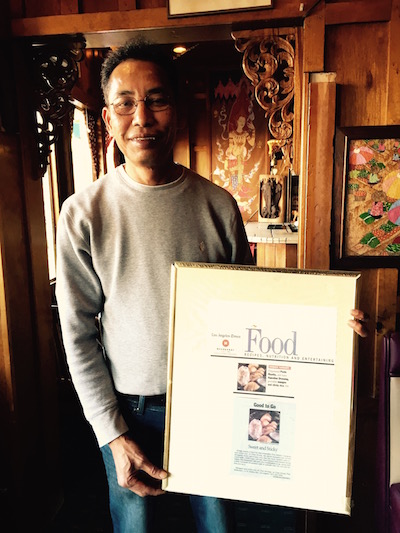











 Sax proves entirely accurate in his passionate, entertaining and perceptive homage to the Jewish delicatessen. starting with a glowing chapter on Los Angeles family-run delis with a critical view of that impersonal deli corporation (Jerry’s) sandwiched into it.
Sax proves entirely accurate in his passionate, entertaining and perceptive homage to the Jewish delicatessen. starting with a glowing chapter on Los Angeles family-run delis with a critical view of that impersonal deli corporation (Jerry’s) sandwiched into it.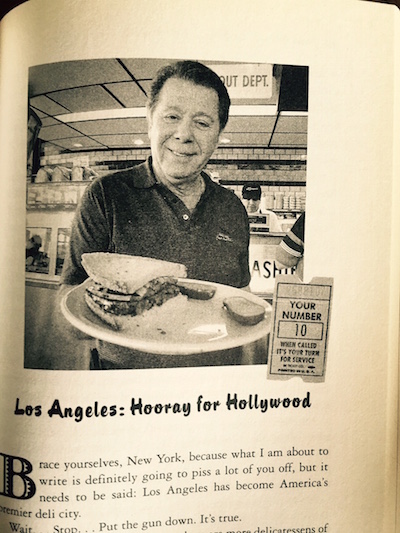
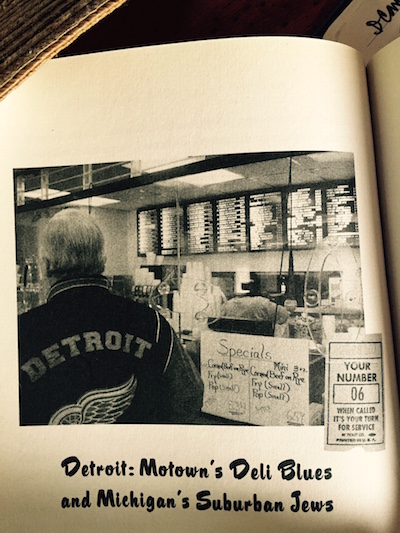 Sax can sum up, with cultural nuance, the history of Jews in England, Poland or anywhere, otherwise becoming entire chapters of tedious rhetoric in history books. His account of Poles in contemporary delis, vainly attempting to revive traditions lost along with most of the Jewish population during World War II, is memorable, bittersweet and heart-wrenching.
Sax can sum up, with cultural nuance, the history of Jews in England, Poland or anywhere, otherwise becoming entire chapters of tedious rhetoric in history books. His account of Poles in contemporary delis, vainly attempting to revive traditions lost along with most of the Jewish population during World War II, is memorable, bittersweet and heart-wrenching.
 So. Sax’s book began as a lament for and memorial to delis, a long way from their start as pushcarts operated by Eastern European immigrants on Manhattan’s Lower East Side. You only have to think of the calories and cholesterol in this health-conscious culture! But he surprisingly discovered a hardy and evolving and growing, if struggling, deli culture. He concedes that “a new breed of deli” can “bring the Jewish delicatessen into the twenty-first century, while staying faithful to the flavors of the nineteenth.”
So. Sax’s book began as a lament for and memorial to delis, a long way from their start as pushcarts operated by Eastern European immigrants on Manhattan’s Lower East Side. You only have to think of the calories and cholesterol in this health-conscious culture! But he surprisingly discovered a hardy and evolving and growing, if struggling, deli culture. He concedes that “a new breed of deli” can “bring the Jewish delicatessen into the twenty-first century, while staying faithful to the flavors of the nineteenth.”









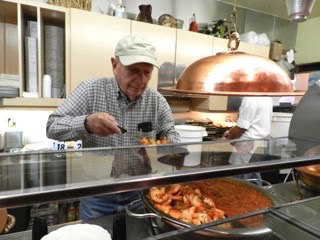




 Chef Andre’s philosophy of providing his customers with value played a big part in his decision to open the more casual neighborhood Andre’s in 1963 and see through his vision of how every family could enjoy a healthy and satisfying meal together without having to “break the bank.”
Chef Andre’s philosophy of providing his customers with value played a big part in his decision to open the more casual neighborhood Andre’s in 1963 and see through his vision of how every family could enjoy a healthy and satisfying meal together without having to “break the bank.”
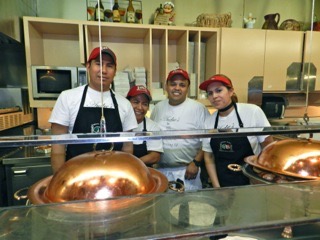

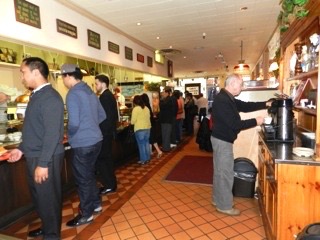
 Since noodles are a mainstay of Asian cultures, Korean faces have popping up more and more at Andres.
Since noodles are a mainstay of Asian cultures, Korean faces have popping up more and more at Andres.





 Gerry Furth-Sides
Gerry Furth-Sides  Barbara Hansen
Barbara Hansen  Chef-owner Alain Cohen
Chef-owner Alain Cohen  Roberta Deen
Roberta Deen  Jose Martinez
Jose Martinez  Nivedita Basu
Nivedita Basu